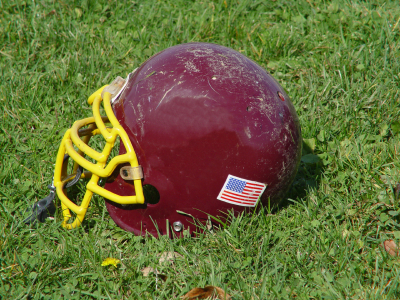The risk of sustaining a concussion in high school football is not affected by the brand, age of the helmet, or recondition status, or by the type of mouth guard worn, say researchers from the University of Wisconsin in a new study. [1,9,10]* 
"According to our research, lower risks of sustaining a sports-related concussion (SRC) and its severity were not improved based on a specific manufacturer. In addition, the SRC rates were similar for players wearing new helmets, as compared to those wearing older ones," said lead author, Timothy McGuine, PhD, ATC of the University of Wisconsin.
"It is also interesting to note, that players who wore a generic mouth guard provided by the school had a lower rate of SRC compared to players with more expensive mouth guards."
Study details
Some football helmet manufacturers suggest that players who wear their helmets - especially new models - may be at lower risk of concussion than those who wear competitors' models or older helmets, basing their claims on how well the new or newer helmets absorb and lessen some of the impact forces that cause concussion in biomechanical studies performed in the controlled environment of the laboratory. Some manufacturers of specialized mouth guards have likewise claimed their products reduce the risk of concussion.
To determine which type of football helmets and mouth guards are associated with a lower incidence and severity of concussions in high school football players, McGuine and his colleagues worked with certified athletic trainers (ATCs) to collect data on 2,288 players at 36 public and private high schools in Wisconsin during the 2012 and 2013 football seasons. More players wore helmets by Riddell (51%) than those by Schutt (30%) or Xenith (19%). The most commonly worn helmet models by brand were the Riddell Revolution Speed, Schutt DNA Pro, and Xenith X1.
Because previous research [2] suggested that a poorly-fitted helmet could increase concussion risk, ATCs were encouraged to follow manufacturers' recommendations regarding initial helmet fitting and to check helmet fit weekly over the course of the season to make sure that are properly fitted.
The researchers reported:
- 251 players (19%) sustained at least one SRC within the last 6 years;
- 206 (9%) experienced SRC playing high school football, the majority (60%) during games, with the SRC rate 7 times higher for competition versus practices, and 4 times higher during full-contact practice sessions than sessions where no contact was allowed. [For an article discussing the growing concern about repetitive head impacts in football, and the movement to limiting the number of full-contact practices, click here; a 2013 study [13] found that head impact magnitude was significantly higher during competitions, but that limiting contact during practice sessions could reduce the number of impacts up to 39% over the course of a season];
- Five (2.4%) sustained 2 concussions within the same season, while 1 subject sustained a concussion in both the 2012 and 2013 seasons;
- The most common mechanism of injury was tackling (23%), followed by contact with an opponent (20%), and being tackled (14%);
- no statistically significant difference in the concussion rate by the type of helmet worn, helmet age (determined by purchase year), or helmet recondition status;
- no difference in the severity of the concussion sustained as measured by days lost to practice/games;
- the SRC rate for players who wore a specialized or custom-fitted mouth guard was significantly higher than for players who wore a generic mouth guard provided by their school (a finding McGuine and his co-authors admitted was "unexpected");
- no increased risk of concussions associated with age, body mass index (BMI), grade in school, level of competition, or years of tackle football experience (contrary to limited retrospective data suggesting that the risk of SRC increases in older players who are competing at a higher level)[11,12];
- players with a history of SRC within the previous 12 months were almost twice as likely to sustain another one compared to players without a history, a finding consistent with numerous earlier studies. [2,3]. That increased risk exists even when controlling for the players' use of protective equipment, years of football experience, and player characteristics, such as their grade in school and competition level, however, was a finding which the authors said was novel and which "further highlight[ed] the need for medical providers to document a history of SRC in young football players" as well as the need to educate players, parents, and coaches about the increased risk of concussion risk in individuals with a previous history of concussions.








